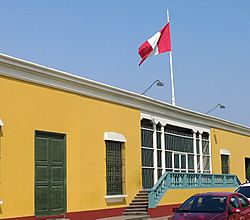Palacio de la Magdalena (Peru) facts for kids
Quick facts for kids Magdalena Palace |
|
|---|---|
|
Palacio de la Magdalena
|
|

The building in 2013
|
|
| Alternative names | Quinta de los Libertadores |
| General information | |
| Architectural style | Spanish colonial |
| Location | La Magdalena, Peru |
| Owner | Government of Peru MNAAHP |
The Magdalena Palace (or Palacio de la Magdalena in Spanish) is a very old and important house in Lima, the capital city of Peru. It's in a part of Lima called Pueblo Libre. This palace is also known as the Quinta de los Libertadores, which means 'Country House of the Liberators'. In 1972, it was officially named a national monument, meaning it's a special part of Peru's history.
Contents
A Palace Full of History
The Magdalena Palace has seen many important moments in Peruvian history. It was once the home of the second-to-last Viceroy of Peru, Joaquín de la Pezuela. A viceroy was like a governor who ruled a colony for the King of Spain.
Home to Heroes
The palace is famously called Quinta de los Libertadores because two great heroes stayed there. These heroes were José de San Martín and Simón Bolívar. They were known as "Liberators" because they helped South American countries, including Peru, gain independence from Spain.
During the Peruvian War of Independence, both San Martín and Bolívar used the palace as their main base. This made the Magdalena Palace a very important place for planning the fight for freedom.
During the War of the Pacific
Later, during the War of the Pacific, the palace played another role. This war was fought between Chile and Peru (with Bolivia). While Chilean forces occupied Lima, the Magdalena Palace became the seat of the Peruvian government. President Francisco García Calderón led the country from here. His government was the only one recognized by Chile during that time.
What the Palace Looks Like
The Magdalena Palace is a great example of Spanish Colonial architecture. This style of building was common when Spain ruled Peru. It shows how buildings looked during that time.
Today, parts of the palace and its surrounding land have been changed. They now house the National Museum of Archaeology, Anthropology and History of Peru. This museum helps people learn about Peru's ancient past and its rich culture.
See also
 In Spanish: Palacio de la Magdalena (Lima) para niños
In Spanish: Palacio de la Magdalena (Lima) para niños
- Government Palace, the current main building for the government of Peru.
- Huaura Museum, where San Martín stayed and first announced Peru's independence before reaching Lima.

